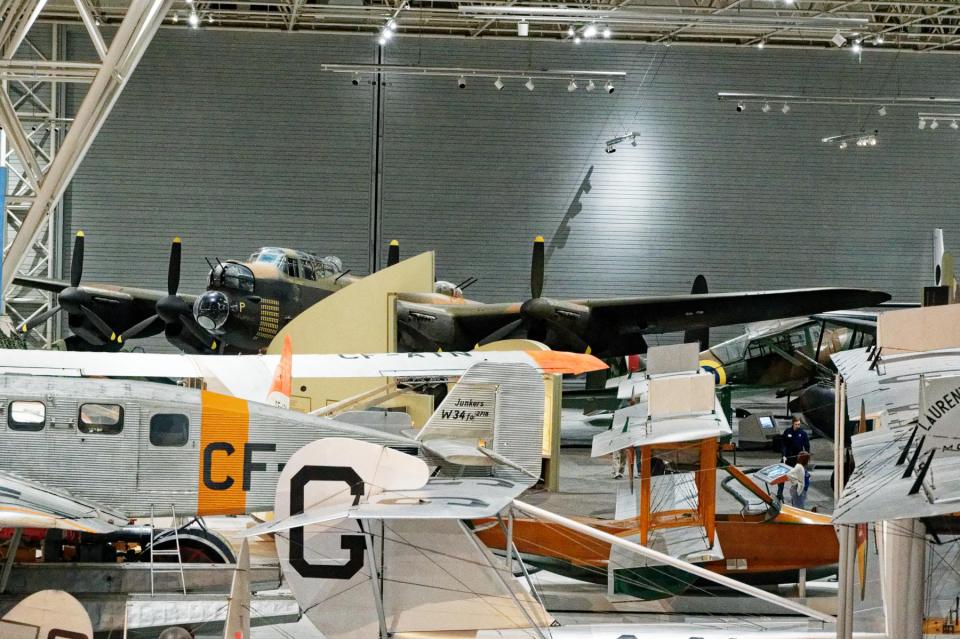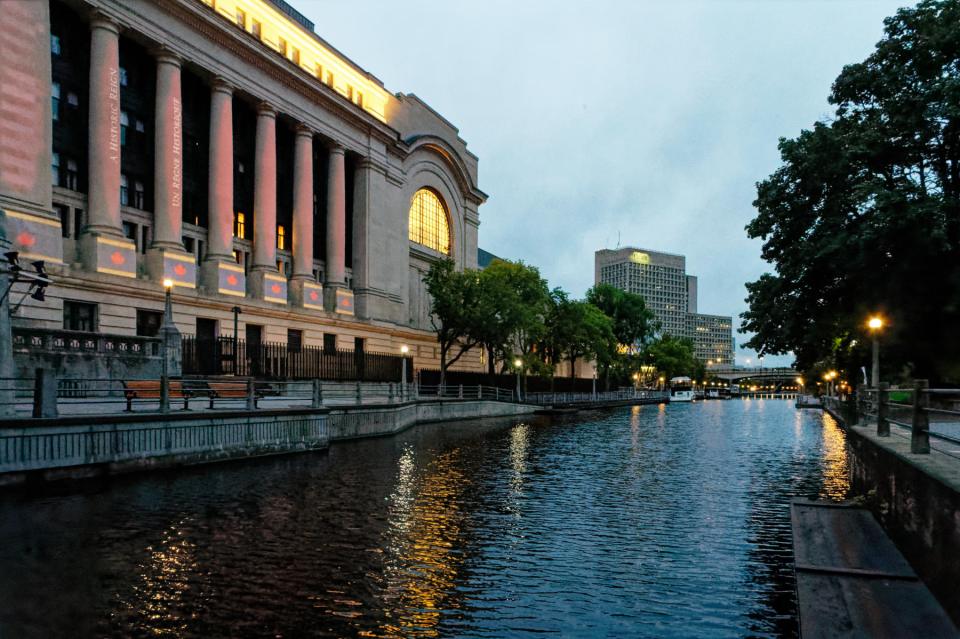Sunday 18 September 2022 – The weather forecast for the day was rather wet and gloomy, and in any case we’d explored most of what was accessible on foot from the hotel, so we made a plan that said we’d take the hop-on-hop-off bus to view the further reaches of the city. So, how was the weather?

At this point in the day, it was drizzle rather than historic rain (and I wonder if anyone in Canada had thought about labelling this image “A Historic Reine” as a sort of bridge between English and French-speaking locals?). What rain that there was made photography from the top deck of a (closed-top!) moving bus rather tricky. We managed a couple of shots of passing street art



and decided that the only destination worth getting off the bus in the rain for, was the Aviation and Space Museum, which has a mind-boggling display of aircraft of all sorts,


as well as a much smaller area dedicated to satellites and other Space-related materials.
There follow a number of photos of aeroplanes, for which I make no apologies, as I’m passing interested in them, particularly historic ones; and there’s a decent joke towards the end, so it may be worth your while reading on.
We accidentally timed things right such that we were able to join a guided tour, which went round highlighting certain areas where planes were grouped. Early Aviation had a section and featured this original Blériot XI, which was a huge commercial success for Louis Blériot after his pioneering flight across the channel.

World War I had a section, of course. It contained a version of my favourite WWI aircraft, the Sopwith Camel (from reading Biggles books as a lad), modified to launch from a ship.

An intriguing section was dedicated to “Bush Planes”, a term we hadn’t come across before, and which means aircraft modified to meet the unique travel requirements of Canada’s wild northern regions (i.e. no runways and no airfields but lots of rivers and lakes). Below is a reproduction of one of the first attempts, with, next to it, the remnants of the original as eventually extracted from the lake it crashed into after an unsuccessful landing.

Also on display was a De Havilland Beaver, probably the most successful Bush Plane in Canada’s aviation history, here shown with the unprecedented volume of cargo one could fit into it and still be able to get airborne. One certainly managed to ferry us from Victoria to Farewell Harbour earlier in our trip, as you will remember because you were paying attention, weren’t you?

An interesting angle on Bush Planes is shown with this Junkers W-34, a plane to which one could fit floats, wheels or skis to help access a variety of terrains. You can see a model of an airman taking a wheel off, presumably to leave the floats active. To do this, he had to lift the plane somehow, and the exhibit shows that he had to chop down trees to make logs to use as a crane, rig up ropes to lift the plane and be able to change its undercarriage type. He was alone, so he had to be pilot, navigator, mechanic, lumberjack and structural engineer, all rolled up into one.

Of course, aeroplanes were used to distribute mail, but in the severe winters, landing and taking off could pose a problem if the fuel lines froze. The solution was to have a hatch in the floor of the aircraft so the mail could be parachuted down.

There was, of course, a section dedicated to WWII aeroplanes. One display had a Hurricane, a Spitfire (another plane I love) and their enemy – a German ME 109, which I’d never seen close to before.

The museum has a Lancaster, the first time I’ve ever been in the same room as one. It’s their biggest exhibit in the hangar, displayed with bomb bay doors open to show how the passing air would arm the bombs by spinning their propellers, before they were dropped. This was OK provided all of them were dropped, but problems were inevitable if something prevented dropping the entire load of up to seven bombs, as landing with an armed bomb under the pane was bound to end in tears.



There were also several aircraft from the Cold War era, such as this Lockheed Martin F18 (foreground) and Avro Arrow (background). The Arrow was far more advanced (Mach 2.5) than the F18 (Mach 1.8), but never made it into production and all examples destroyed save the portion on show here.

We learned that many aeroplanes used as trainers were painted a bright yellow.

This served several useful purposes: identifying aeroplanes to steer clear of if in operation; making it clear that they were not combat aircraft; and making it easy to find the pieces in the event of a crash.
There were several charming elements in the display, such as this helicopter with its rodent grin;

a rather poorly-placed warning over an aircraft’s gun

since if you were able to read it you were already in serious danger; and toy planes for the kids to whizz about on;

One exhibit was called an “ornithopter”, which I was very curious about, having had my head filled with images from sci-fi books and films such as “Dune”. It turned out to be “Snowbird” – the first successful human-powered aircraft – very light, and with an enormous wingspan.

And so passed an enjoyable 90 minutes at the museum. But I can’t allow you to leave without the joke I promised. In all of the aeroplane exhibitions I’ve seen before, the plane were all “ours”, i.e. British/Allied, rather than enemy. By having at least one German plane on display, this museum allowed me to show you a picture of one of them Fokkers. (Decent joke??? Hah. Ed)

I suppose using the hop-on-hop-off bus to visit just one place in Ottawa wasn’t the most effective use of resources, but we really enjoyed the museum and did get to see some other places outside the immediate environs of Parliament Hill, albeit not very clearly.
We had to scamper rather back to the hotel, as it was raining heavily by that stage. But after a late lunch/early dinner the rain appeared to have abated, and we needed a reason to shake down the food (and gin). So we went for a stroll along the banks of the Rideau Canal in the gathering evening.

We passed the Senate,

the Shaw Centre (what is it with Canada and GBS? Anyone?),

an odd-looking boat outside the Shaw Centre,

some bridges,


(the second of which we used to cross the canal and walk back on the other side), that boat again

(very strangely laden), and our final glimpse of the city and Parliament.

This pretty much ended our time in Ottawa. Because of the overwhelming presence of government, it’s a slightly odd place, but one we found it very enjoyable to learn about and walk around. Tomorrow we must leave, taking another Via Rail journey to Québec, where we have a Fabulous Country Tour awaiting us. Let’s hope the weather is clement; please come back in a couple of days to find out.

Absolute, unexpected delight to see the airplanes that my dad used to speak about. And Snoopy flew a Sopwith Camel in the comics! Romantic photos of a soft evening in Ottawa. And yes, the honking and noise from the Strike drove the locals crazy. The fact that the US thought this was a tame strike speaks volumes about the Yanks’ expression of protest. And lastly, I understand Trudeau sang “Bohemian Rhapsody” publicly today – a Queen song in tribute. I must check it out. Thanks again for taking us along. You do a fabulous job in the blog! ️❤️
Thanks again for the kind words 🙂